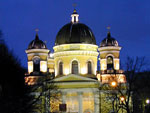Transfiguration Cathedral
 |
| source: petrohol.ru |
Another name for the church is the Cathedral of the Lord’s Transfiguration of all the Guards. The construction of this temple was preceded by a dramatic page in Russian history, namely the enthronement of the Empress Elizabeth after the coup assisted by Preobrazhensky Guards Regiment. It happened on Jan. 25, 1741. To commemorate the event Elizabeth ordered to build a stone temple, the Transfiguration Cathedral, on the site of the house where she had addressed the brave guardsmen. The Baroque style church was laid in 1743 and was consecrated in the presence of the Empress in 1754 on the eve of the Transfiguration holiday. Inside the temple was decorated with Ionic pilasters and molding. Moscow masters carved and gilded 5-level iconostasis and magnificent altar shelter. Unfortunately, in 1825 the cathedral was burnt down completely, but in 1829 it was restored on the same spot. The architect Stasov using the old walls restored the cathedral but gave it strict Empire look. The dome was painted cloudy sky blue; on the sides there are eight angels; in the center - a large star with divergent beams. The walls of the temple are decorated with many icons sent there from the shut down churches.The park, protected by the fence made of Turkish cannons, surrounds the church. Before the gates there are 12 canons and two unicorns. In 1854 the big clock, brought from England, was installed on the church tower.
This is how the cathedral looks today: a majestic building with a huge dome in the center and smaller side towers. The high 4-column portal topped by molded visor marks the entrance to the cathedral. The arched windows are framed with openwork molding. Since the cathedral was dedicated to military regiment, some of its objects are related to the military history of Russia: the captured Turkish flags, the sword of Alexander II that he carried on the day of the assassination attempt, imperial tunics. In 1925 they were handed to the Artillery Museum. The walls were lined with bronze plaques listing the names of officers killed in battles. The temple has never been shut down and being under the state protection as a monument of architecture is in excellent condition.

